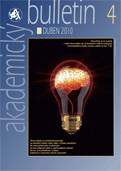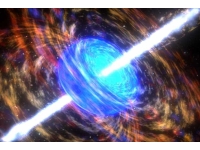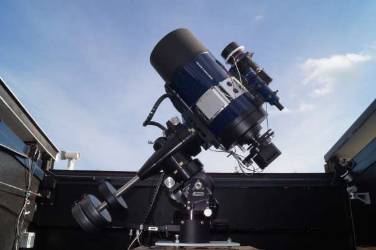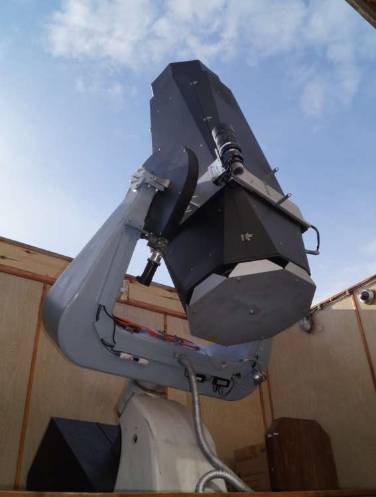Czech Astronomers are the first to have captured the optical afterglow of a gamma burst
On 30 October at 10 PM, a so-called gamma burst flared in the constellation Aquarius. It was recorded in space by the satellite Swift. Astronomers from the Group of Astrophysics of High Energies Group of the Stellar Section of the Astronomical Institute of the ASCR started monitoring it only 41 seconds after the placements of the optic telescope at the observatory in Ondřejov and were so the first in the world. They are gigantic energetic flashes in the area of gamma radiation, which energy comparable with the emission of the Sun for its entire lifespan is released over a few seconds or tens of seconds. The distance of the object in space was calculated as 9 billion light years.
What are gamma bursts
Gamma-ray bursts have been observable since the 1960s, today, sometimes even several times a day. They are gigantic energetic flashes in the area of gamma radiation, which energy comparable with the emission of the Sun for its entire lifespan is released over a few seconds or tens of seconds. Currently, scientists divide the gamma-ray bursts into two types based on the length of their duration.
The short ones last up to two seconds and most scientists judge that they are created in the merger of two neutron stars or a neutron star and a black hole. Such a system can be created as a posthumous child of the twin stars, if both elements of the system survive together also in the final stage of their lives. The system then loses energy in the form of gravitational waves, which the distance of the two compact elements progressively shortens, until there is a dramatic crash.
On the contrary, the long gamma bursts are likely the result of a catastrophic end of gigantic, fast-rotating stars. These explosions, more than 1000x stronger that the explosion of a normal supernova, are called hypernovas. During this process, the core of the star collapses into a black hole on which the remnants of the envelope of the original star fall.
In both cases, a part of the accreting matter is ejected along the axis of rotation and forms a jet of tremendous speed, which reaches almost the speed of light. The massive energy of the jet is then emitted in the radiation area - and a gamma burst is created.
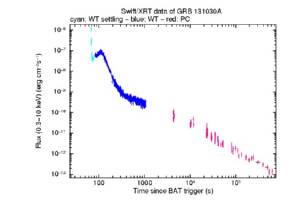 Burst and quick reaction
Burst and quick reactionThe gamma burst of radiation labelled as GRB 131030A was captured by the American satellite Swift on 30 October 2013 precisely at 8:56:19 PM in terrestrial time. Observation has shown that the burst belongs to the group of long gamma-ray bursts. The actual gamma radiation had a total duration of about 45 seconds, which places the burst in the group of long bursts. The maximum intensity of the gamma rays came about six seconds after detection. The Swift satellite automatically sends information on bursts immediately to the terrestrial server, so that every astronomical workplace that has expressed interest in it can find out about the burst. They just subscribe for the updates, because the phenomenon that causes a gamma-ray burst continues in radiation even on longer wavelengths, including in the optical range. Astronomical telescopes are then able to observe the so-called afterglows.
The servers of the Astronomical Institute of the ASCR received information 14 seconds after detection. Both telescopes used by the Group of Astrophysics of High Energies automatically reacted immediately, suspended without delay the routine observation and started the crossover to the position of the gamma burst. BART (Burst Alert Robotic Telescope) was the first to reach the position and began taking photographs. It began to expose the photographs 27 seconds after it received the information, i.e. only 41 seconds after the detection of the burst by the Swift probe. It was recorded by both instruments, hence on the main telescope with a diameter of 25 cm and on a wide-angle camera with a diameter of 10 cm. The second telescope D50 with a mirror diameter of 0.5 meters arrived in place 42 seconds after receiving the information, i.e. 56 seconds after detection. Both telescopes are currently included in the international project GLORIA (http://gloria-project.eu/cs/).
Subsequent observation
The observatories trying to capture the optical afterglows of the gamma bursts mutually inform one another on their successful observation in the circulars of the GCN (Gamma-ray burst Coordinates Network). It arises from them that the Ondřejov astronomers were he first in the world who managed to begin to film the afterglow of this gamma burst. They were in place even before the satellite Swift itself was able to turn to be able to use other instruments on board, including a small optic telescope. An interesting fact is that even the third telescope that observed the phenomenon (round 170 seconds after detection), the Irish telescope WATCHER located in the Republic of South Africa has a trace of Czech astronomers, because it was worked on by a former employee of the Astronomical Institute of the ASCR in the Group of Astrophysics of High Energies Dr. Martin Topinka. The telescope also uses the same guidance software as the two Ondřejov telescopes, which initially were created precisely in the Group of Astrophysics of High Energies.
Both Ondřejov telescopes (or all three detection instruments, including the wide-angle kamera on the BART) reliably detected the phenomenon, already on the first photographs made. The phenomenon was even able to be captured in the initial, brightening phase, so the observation contains also its course in maximum clarity. The simultaneous sensing with three detectors moreover made it possible to achieve a noteworthy time resolution.
The greatest brightness of the object was
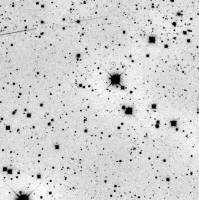
13.8 magnitudes, which places the object among the rare, relatively clear cases of gamma bursts. If a person wanted to observe an optical afterglow with his/her own eyes, a medium-large telescope (with a diameter of at least 25 cm) would be necessary. As is usual, the phenomenon relatively quickly weakened. Despite that, the Ondřejov astronomers were able to detect the gamma burst still the next night, using the technique of assembling photographs, and that again even on both telescopes. Its clarity in the meantime had faded by more than 250x. Also the photograph included comes from the D50 telescope.
Astronomers from Spain managed using the largest telescope in the world Gran Telescopio Canarias with a diameter of the mirror of 10.4 meters, located in the Canary Islands, to measure the spectrum of the entire phenomenon and so determine the value of its red shift z = 1.3. From that, they derived the real cosmological distance of the burst, corresponding to almost 9 billion light years.
A detailed analysis of the measurement and acquired light curve will be published by the scientists from the Group of Astrophysics of High Energies in a scientific article being prepared, which will likely be elaborated in a wider international collaboration.
What all was managed by the Ondřejov astronomers
* They managed to photograph the afterglow of a gamma burst with two robotic telescopes simultaneously for the first time, even with the use of all three available detectors including a wide-angle camera.
* They managed to observe (with both telescopes and a small camera, so three instruments) as the first in the world according to the information available.
* They captured the maximum of the phenomenon in the optical range, which occurs shortly after the beginning and its capture is not entirely common. In the case of this gamma burst, they were likely the only ones to manage it.
* BART began to photograph already at the time when the actual primary gamma burst was still ongoing (the initial radiation in the gamma range).
* Both instruments were able to detect the afterglow still the following night, which is a unique event, especially for BART (a diameter of only 25cm).
* It is a noteworthy gamma burst, which was very clear and on which a great deal of data in various spectral ranges were (subsequently) acquired, including by satellites and the largest telescopes of the world. The Ondřejov telescopes in that ensured the acquisition of crucial information and so became a substantial and indispensible part of the whole mosaic, which allows the extraction of valuable scientific information from the entirety of this exceptional phenomenon.
The Group of Astrophysics of High Energies
is under the Stella Section of the Astronomical Institute of the ASCR. The Group is engaged in research of galactic and extragalactic cosmic sources of high-energy radiation in visible light and in the range of X-ray and gamma radiation. The subjects of the research are different types of binary X-ray sources, gamma-ray bursts and optical afterglows, active galactic nuclei AGN (especially blazars). It is currently involved in space projects of the European Space Agency ( ESA) INTEGRAL, Gaia, and ATHENA + LOFT and cooperates with the American NASA on studies within the analogous American projects. To obtain optical data from cosmic sources group has developed and operates robotic telescopes quickly responsive to data from satellites, in particular the detection of cosmic gamma-ray bursts (BART, D50, BOOTES experiments). Other data obtained from astronomical plate archives - the time period covering up to 100 years, providing valuable information about the long-term behaviour of resources in the optical range. The group leader is Doc. RNDr. René Hudec, CSc.and Mgr. Martin Jelinek, currently working at the Andalusian Astronomical Institute of IAA- CSIC in Granada, Spain, is significantly involved research on gamma-ray bursts.
CONTACT:
Doc. RNDr. René Hudec, CSc.
Head of the Astrophysics of High Energies Group of the Stellar Section of the Astronomical Institute of the ASCR
Tel.:
323 620 128
E-mail: rhudec@asu.cas.cz, rene.hudec@gmail.comBART (Burst Alert Robotic Telescope)
D50 Telescope
 13.8 magnitudes, which places the object among the rare, relatively clear cases of gamma bursts. If a person wanted to observe an optical afterglow with his/her own eyes, a medium-large telescope (with a diameter of at least 25 cm) would be necessary. As is usual, the phenomenon relatively quickly weakened. Despite that, the Ondřejov astronomers were able to detect the gamma burst still the next night, using the technique of assembling photographs, and that again even on both telescopes. Its clarity in the meantime had faded by more than 250x. Also the photograph included comes from the D50 telescope.
13.8 magnitudes, which places the object among the rare, relatively clear cases of gamma bursts. If a person wanted to observe an optical afterglow with his/her own eyes, a medium-large telescope (with a diameter of at least 25 cm) would be necessary. As is usual, the phenomenon relatively quickly weakened. Despite that, the Ondřejov astronomers were able to detect the gamma burst still the next night, using the technique of assembling photographs, and that again even on both telescopes. Its clarity in the meantime had faded by more than 250x. Also the photograph included comes from the D50 telescope.


